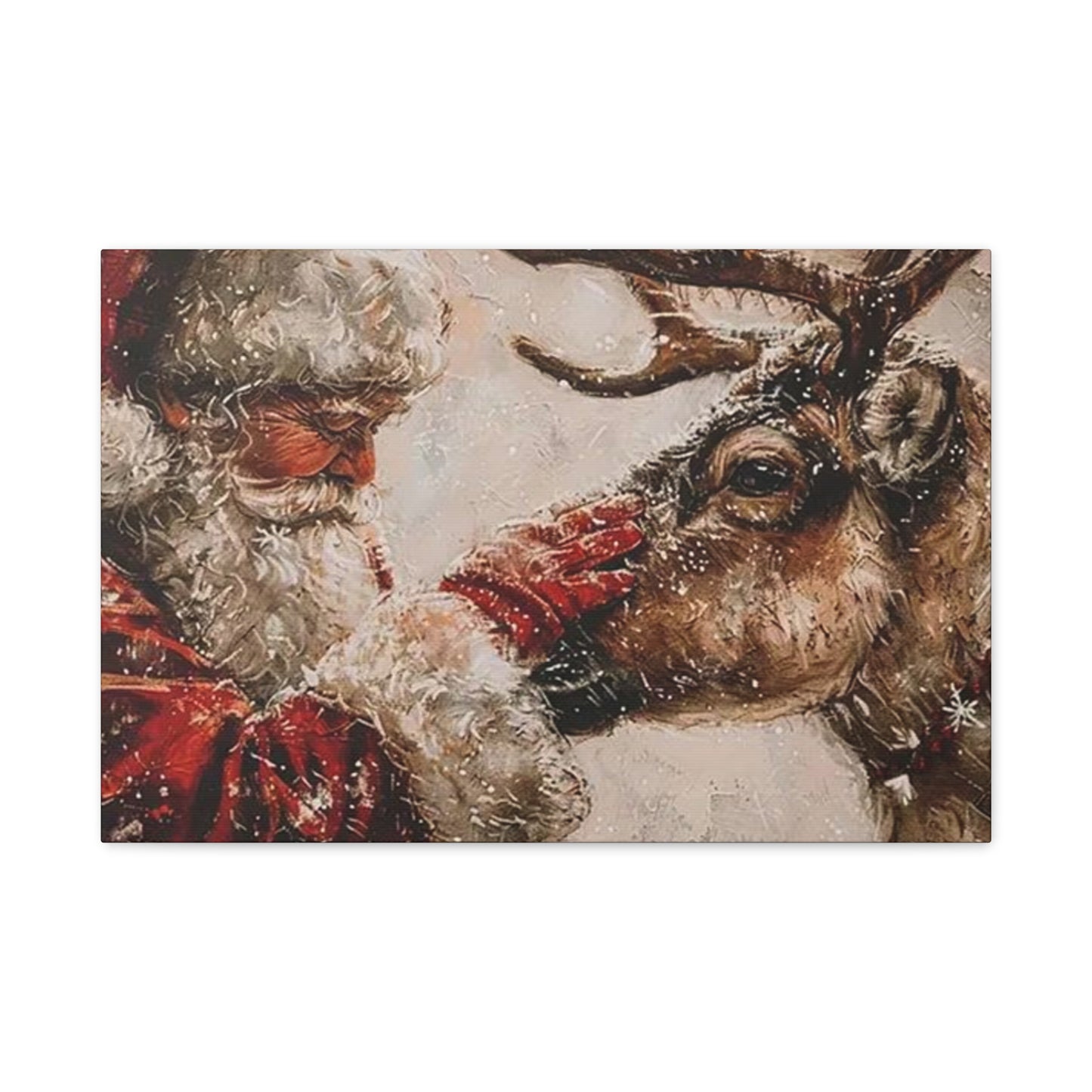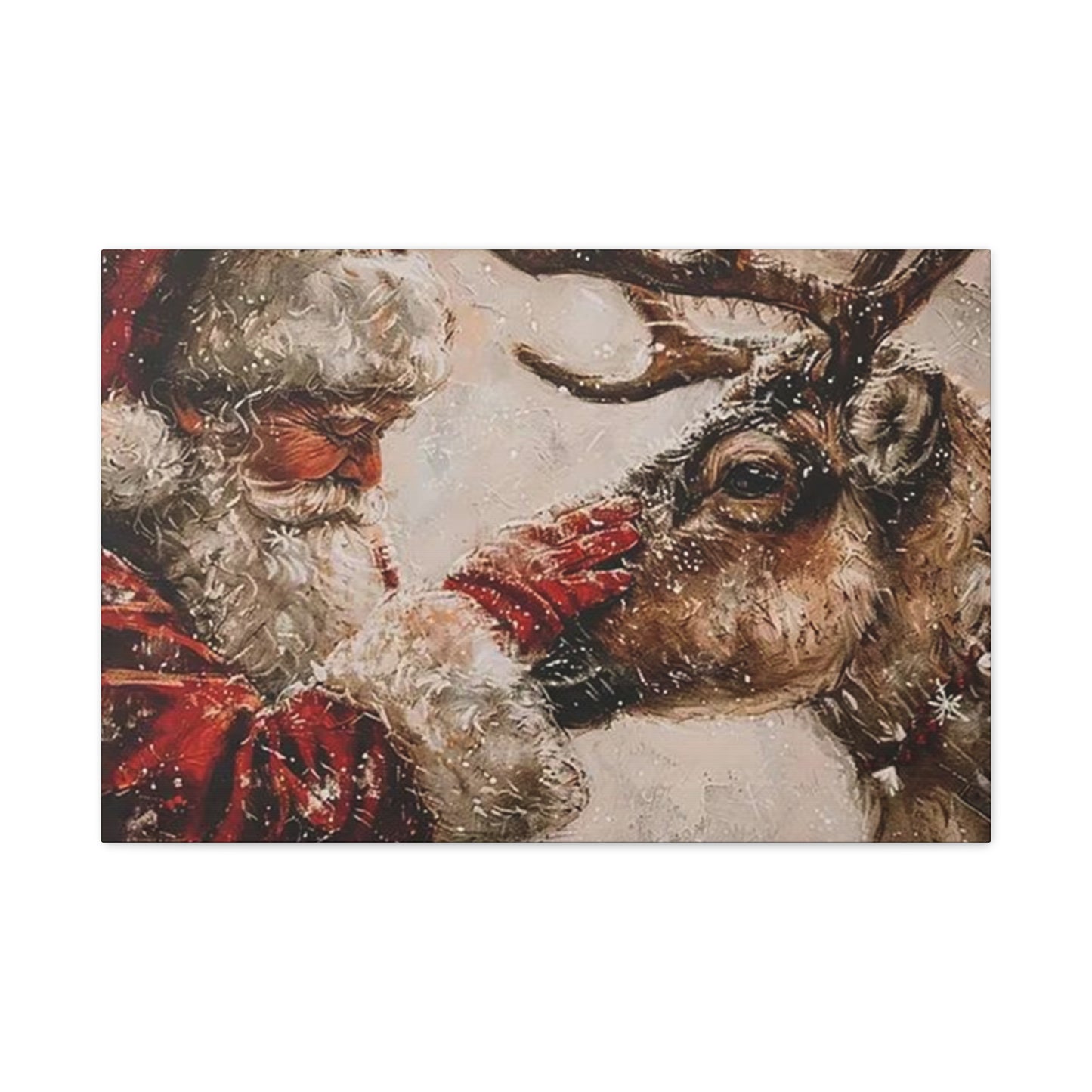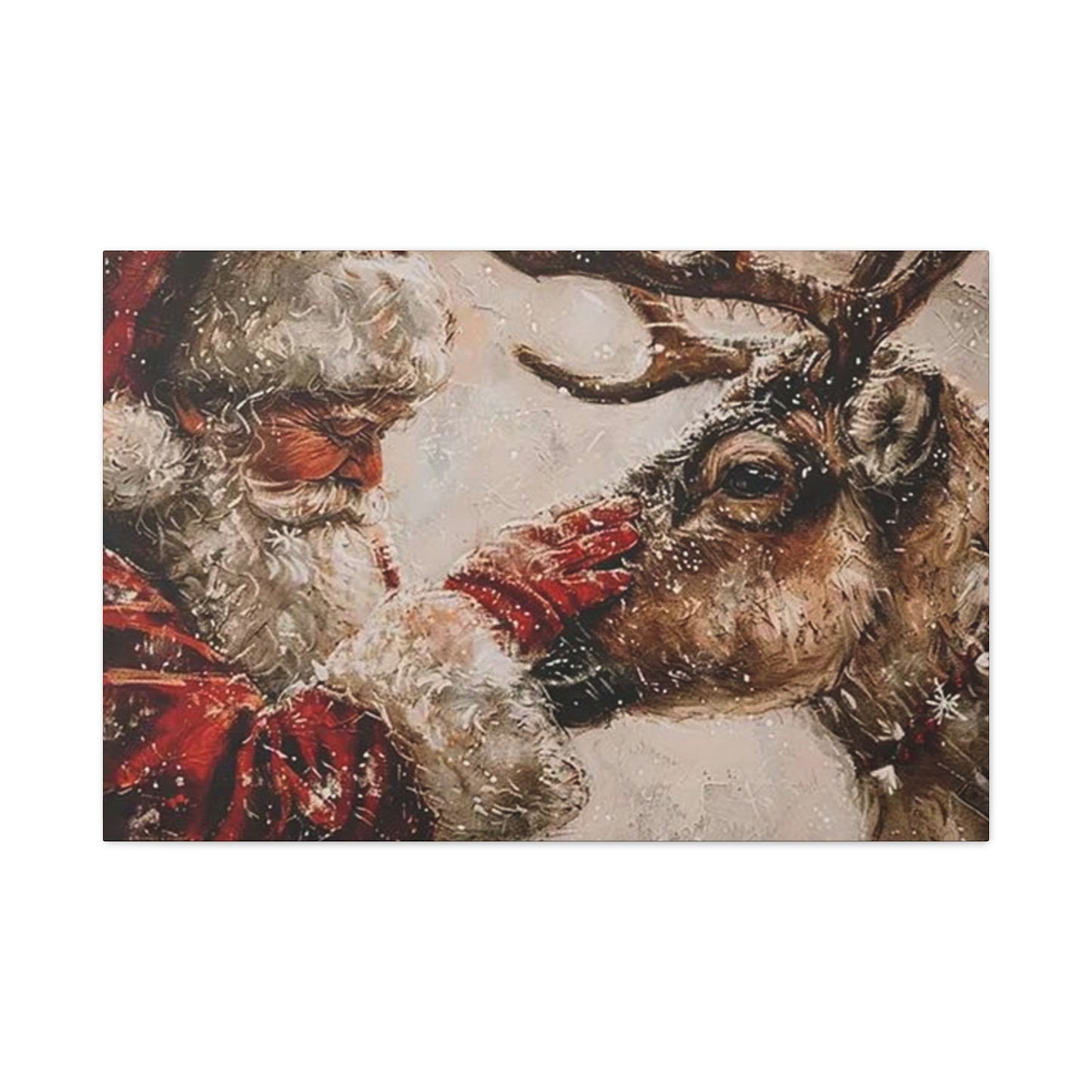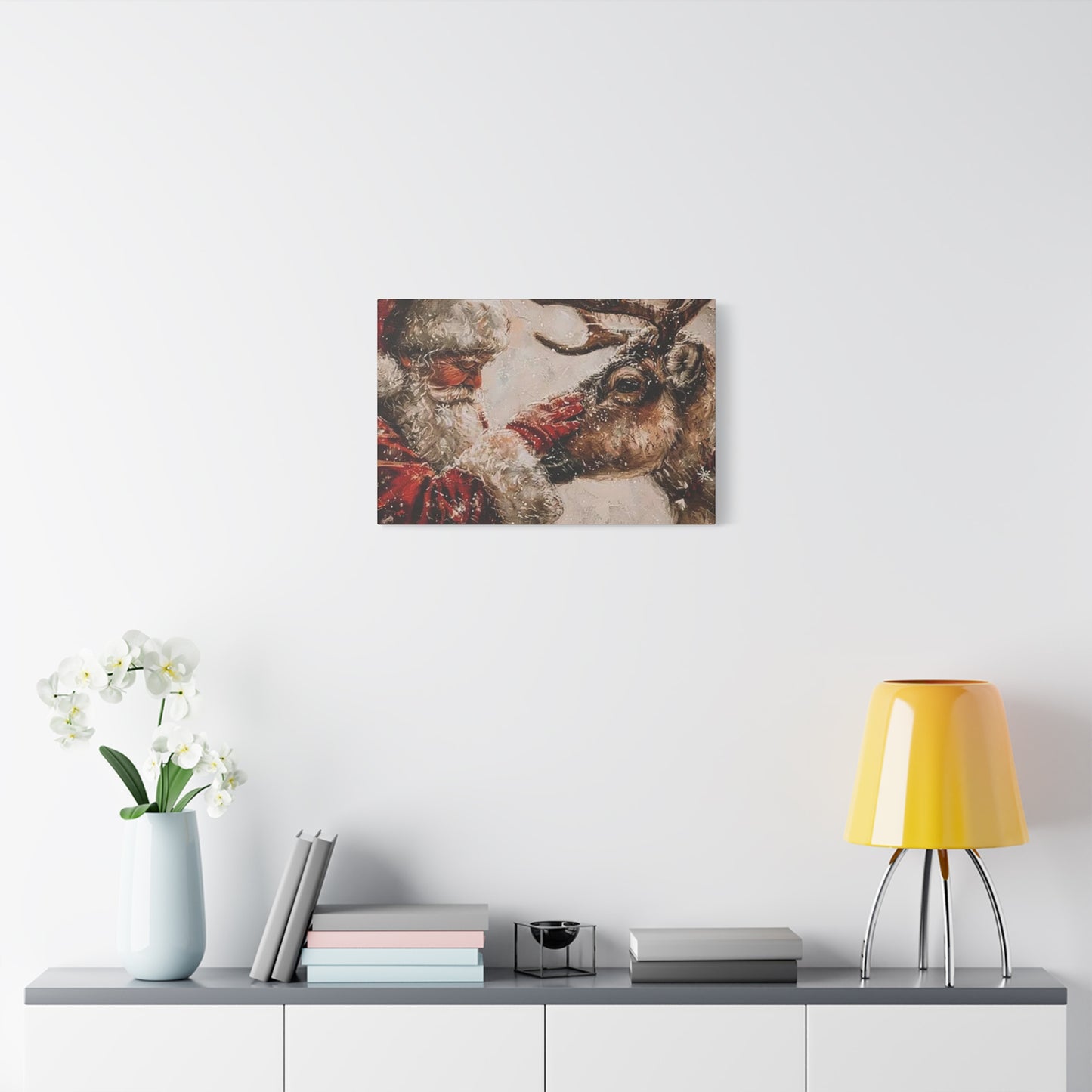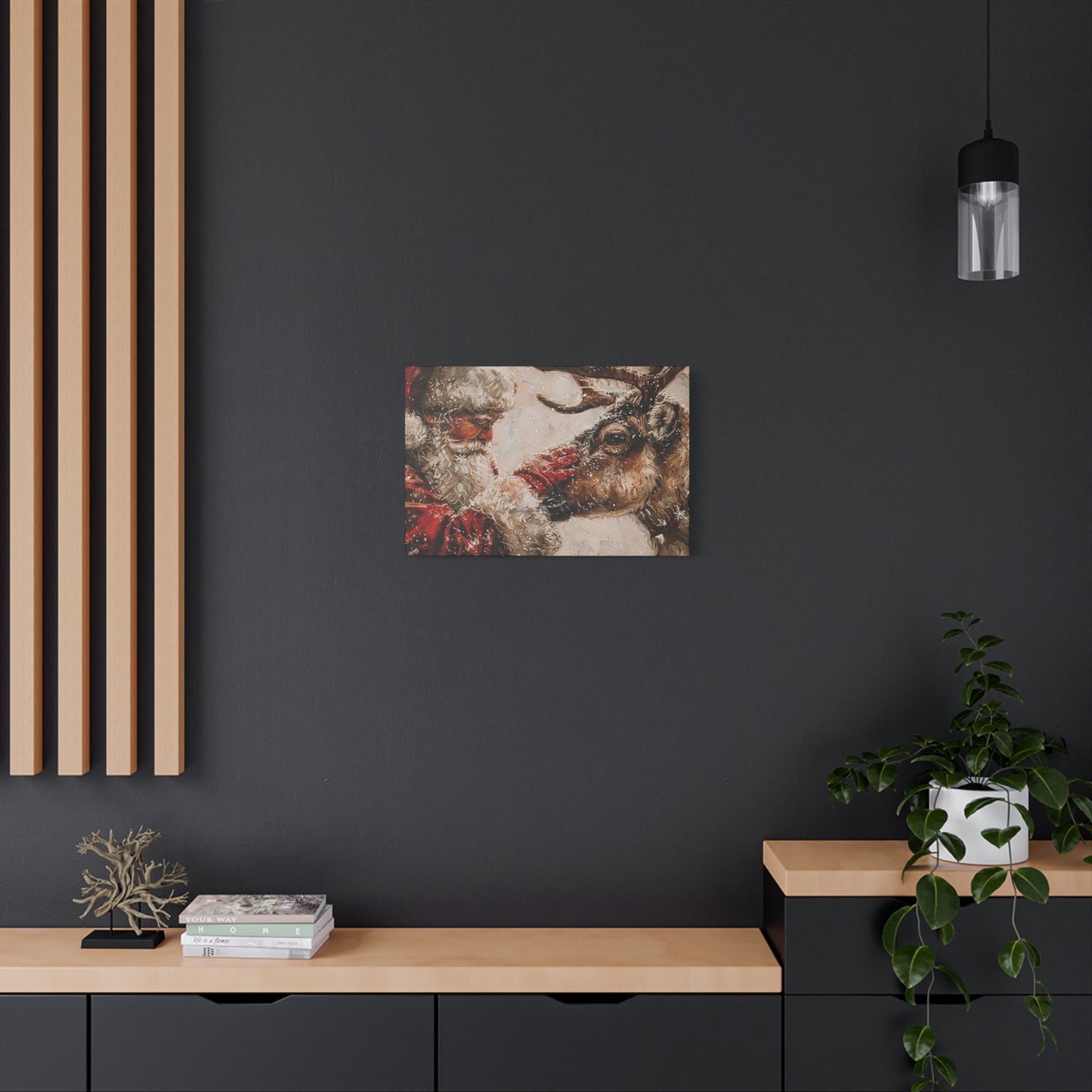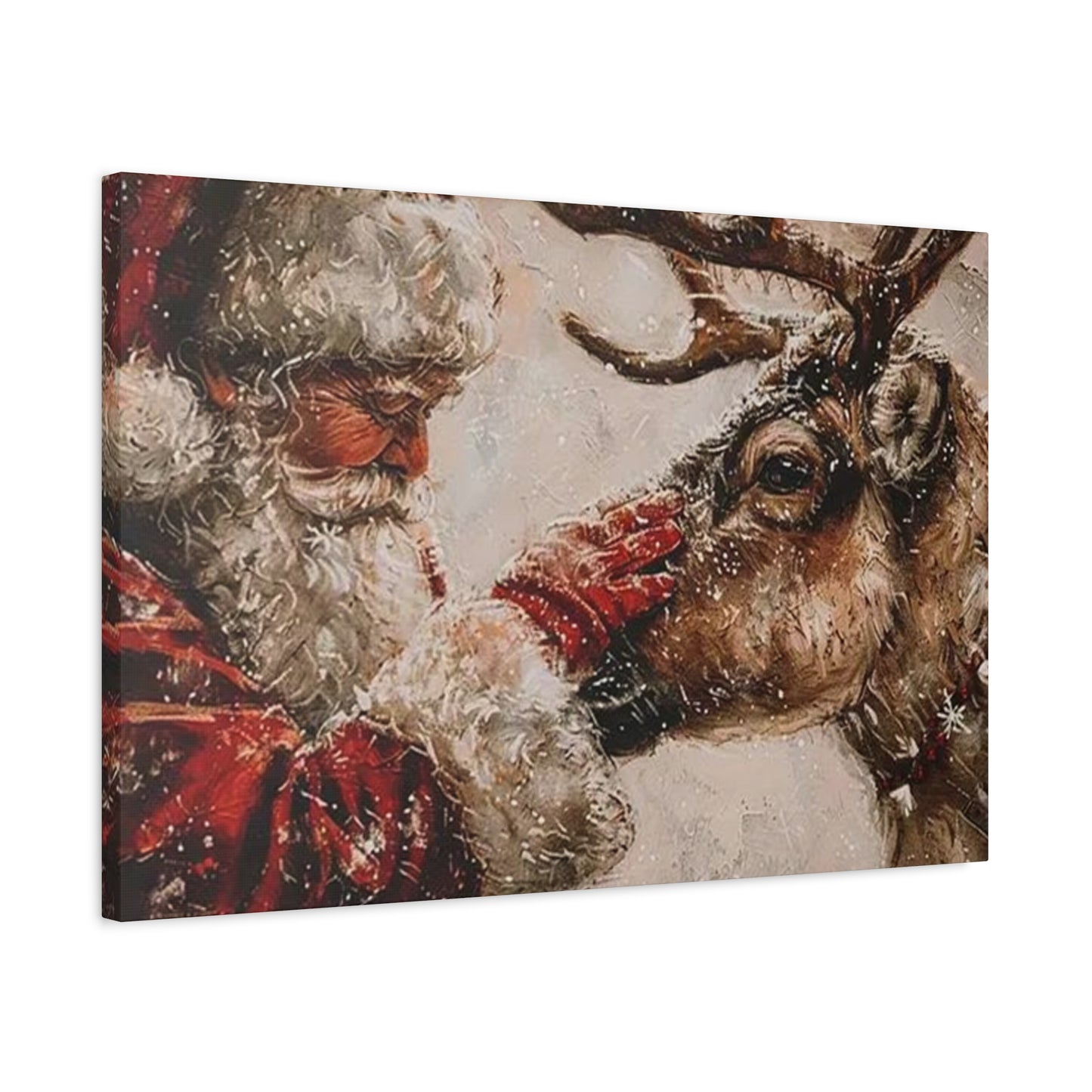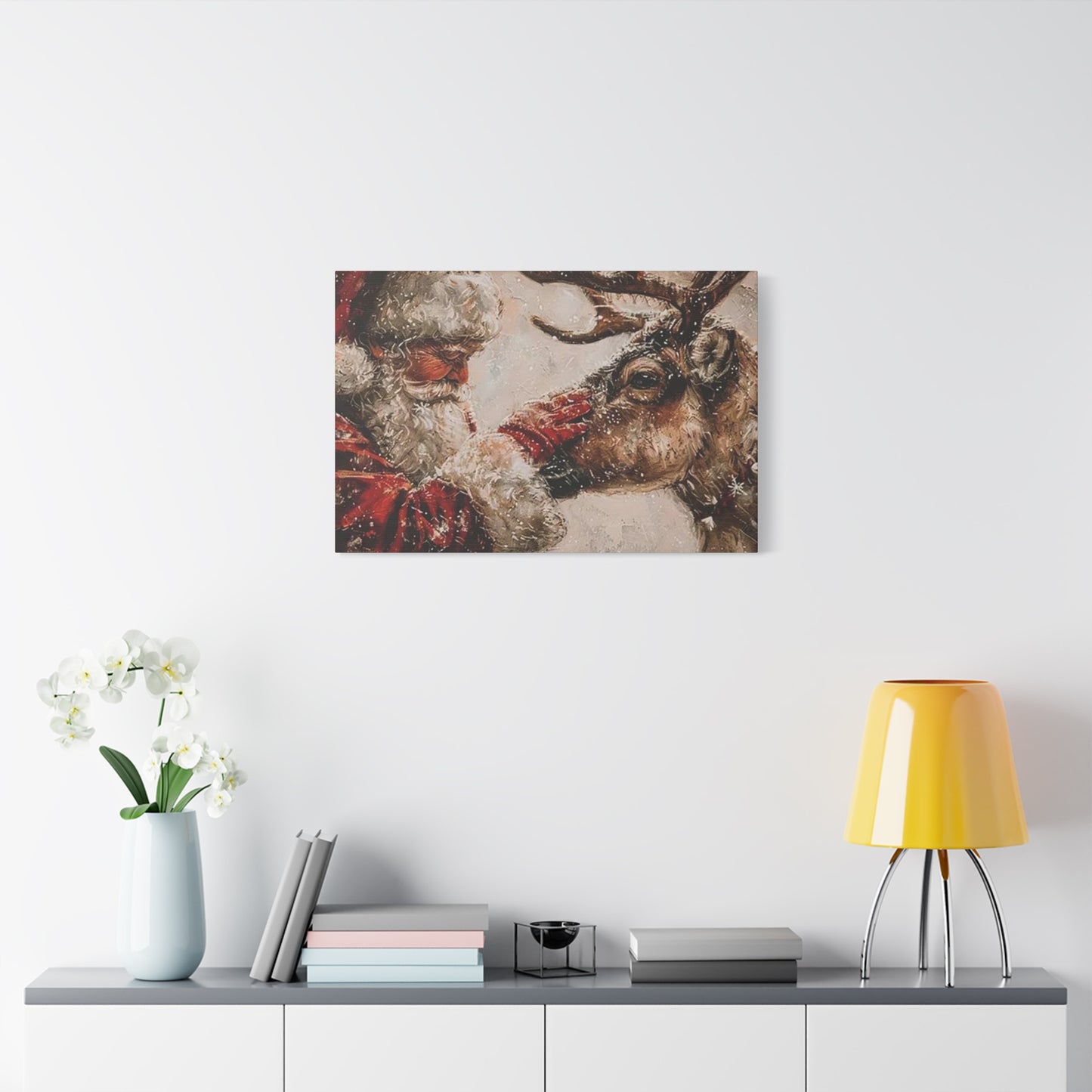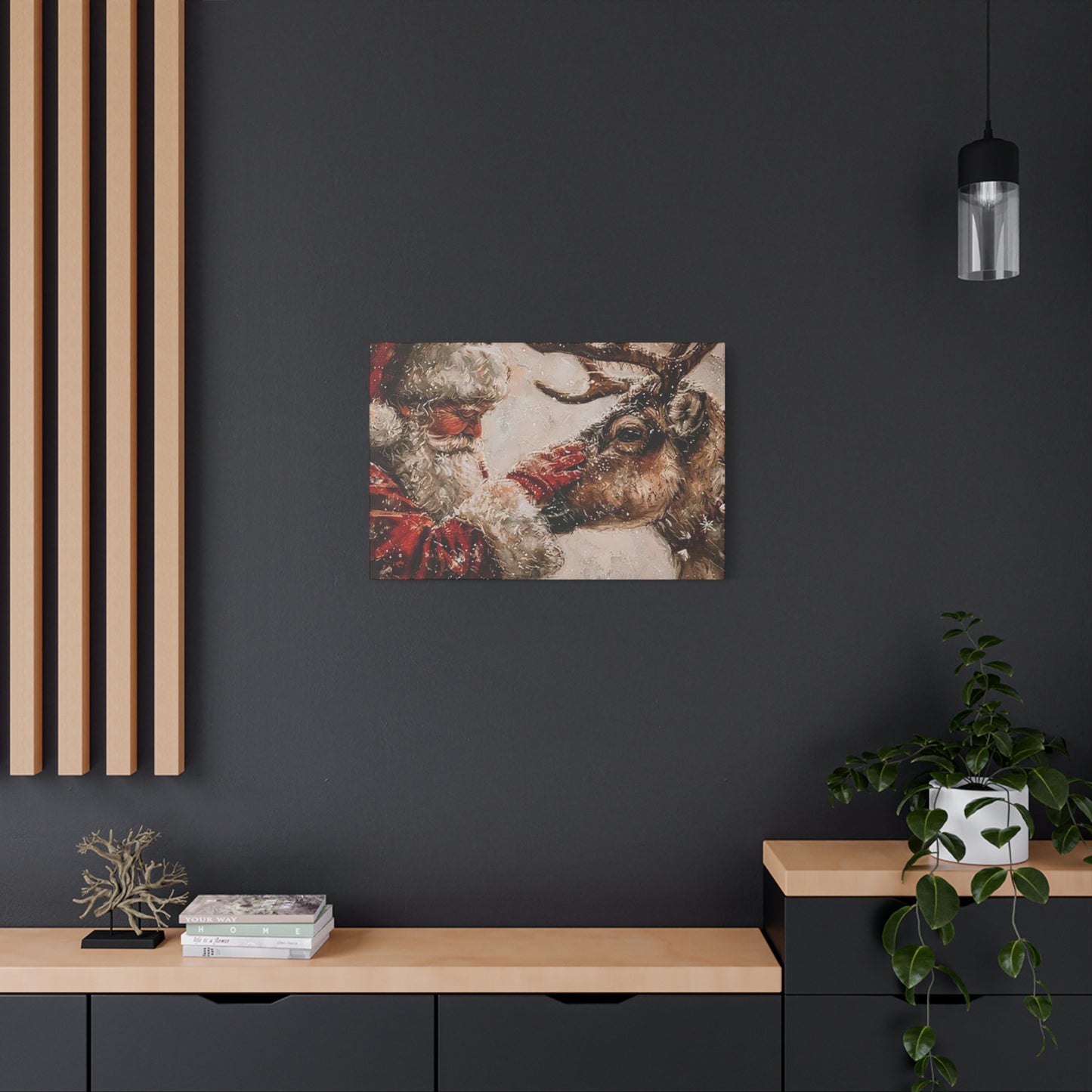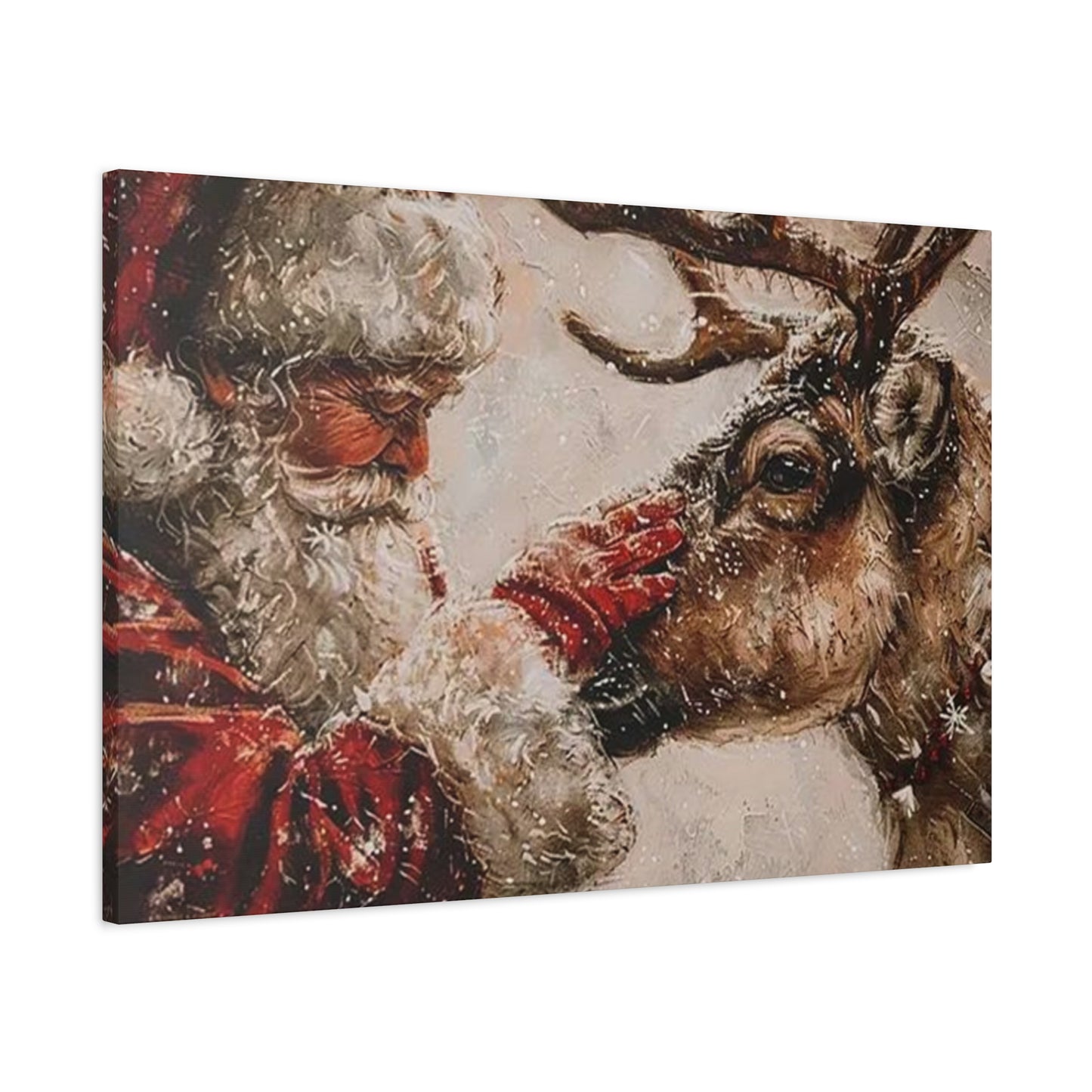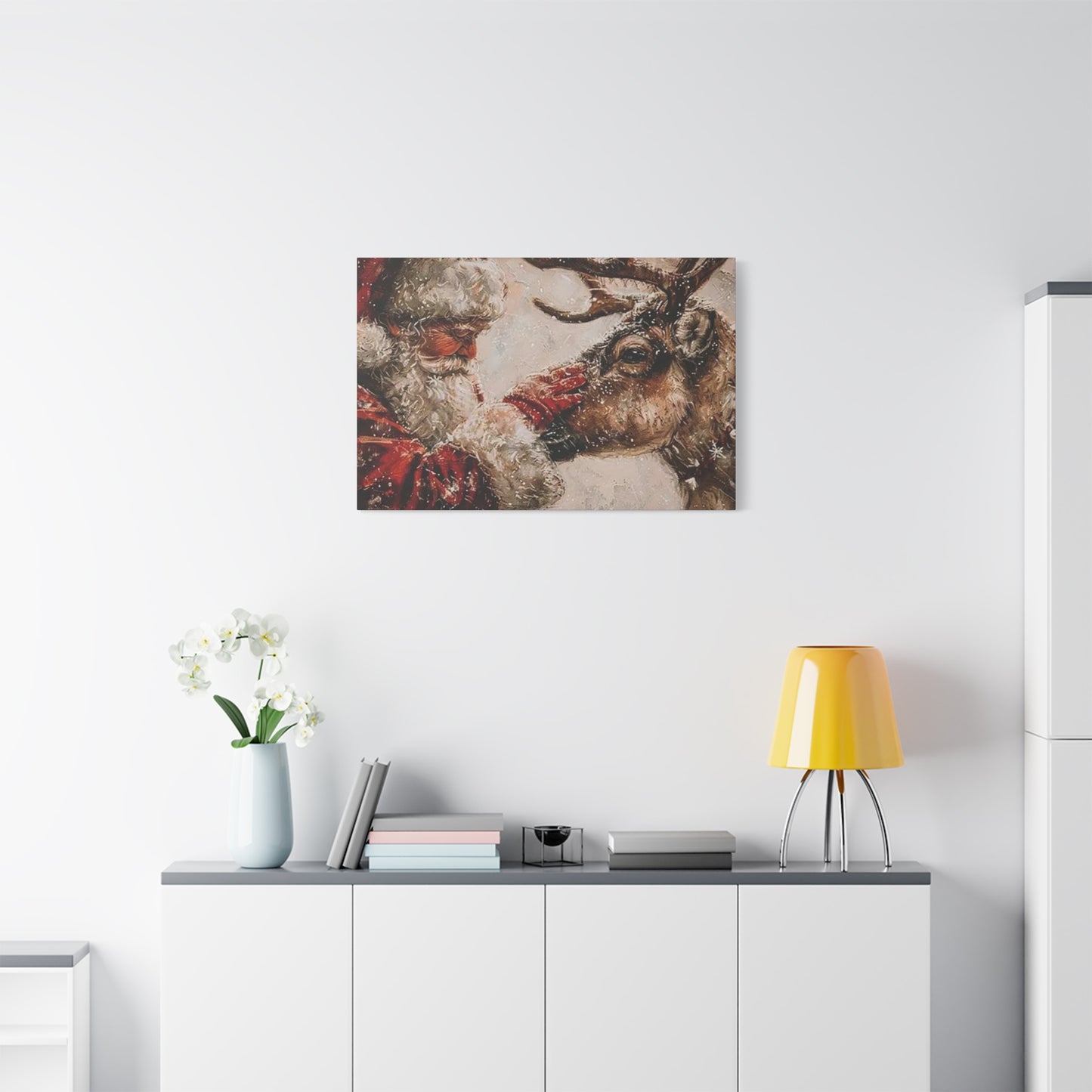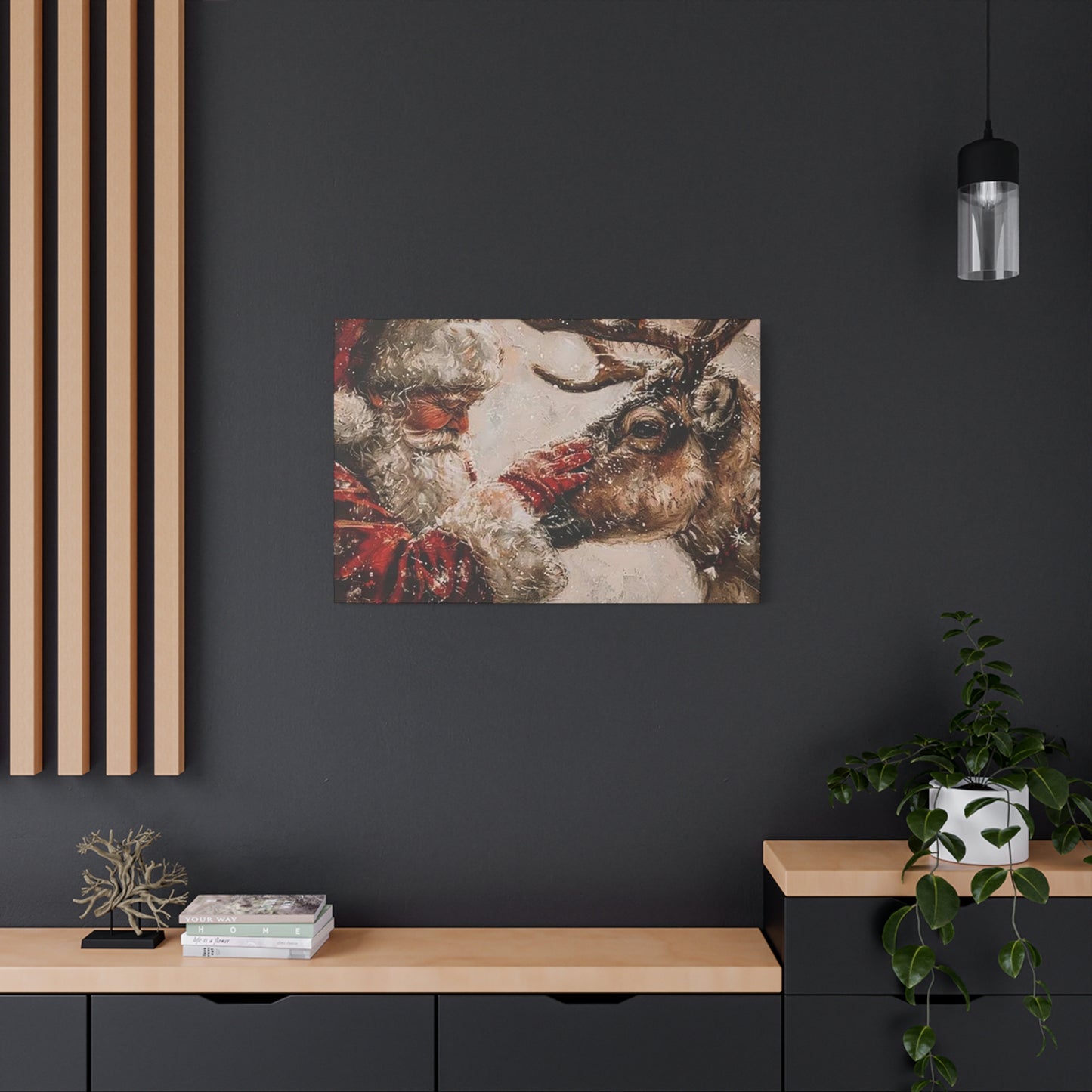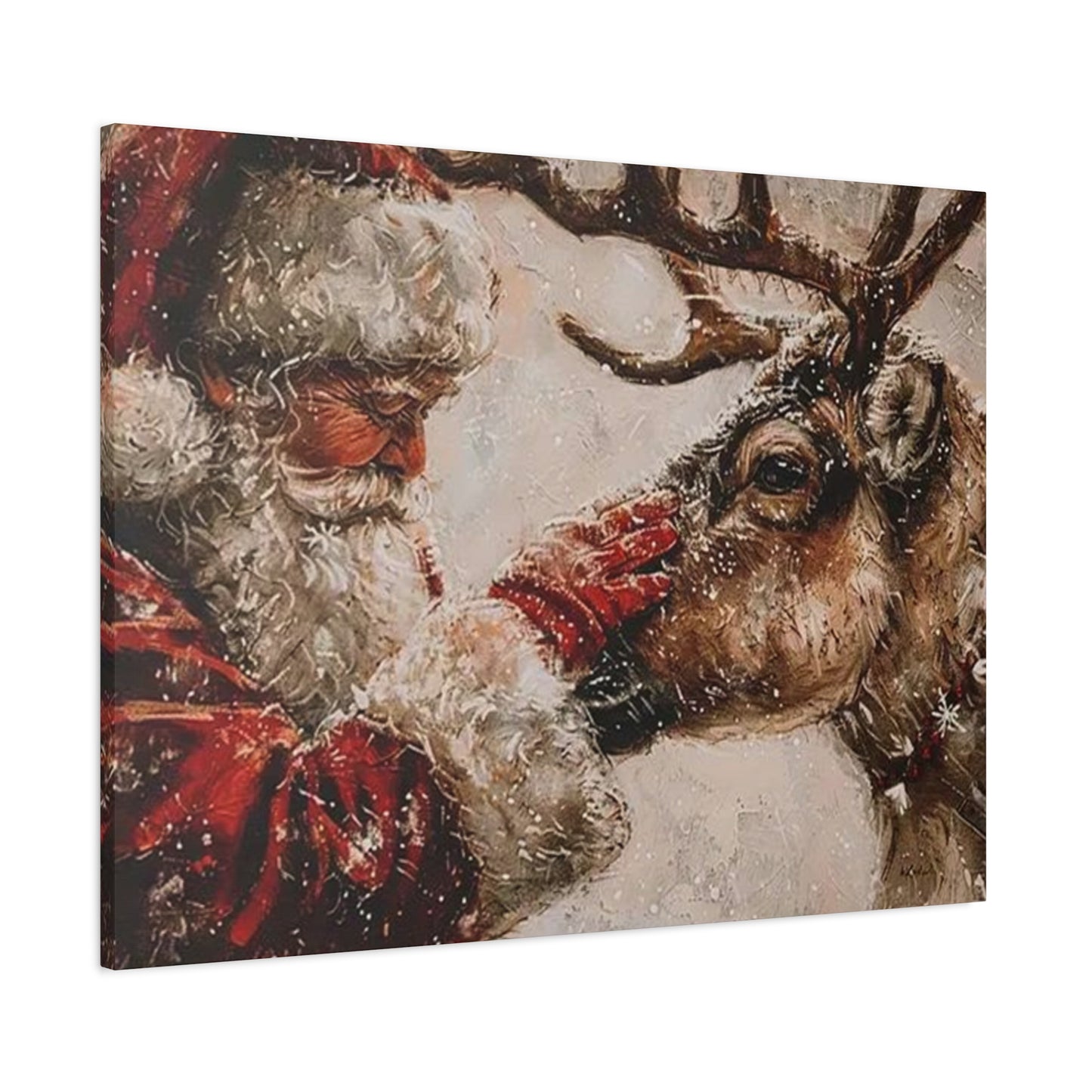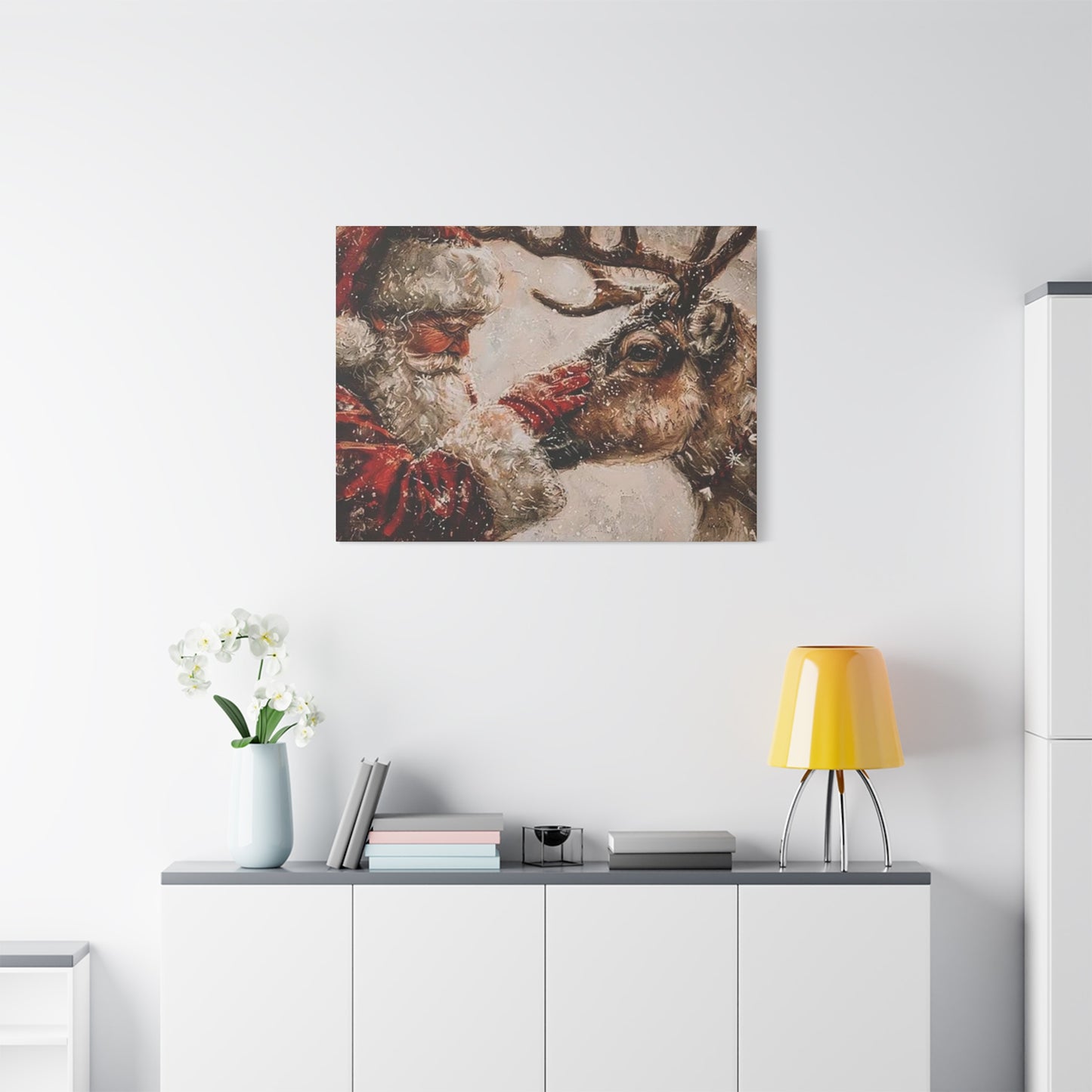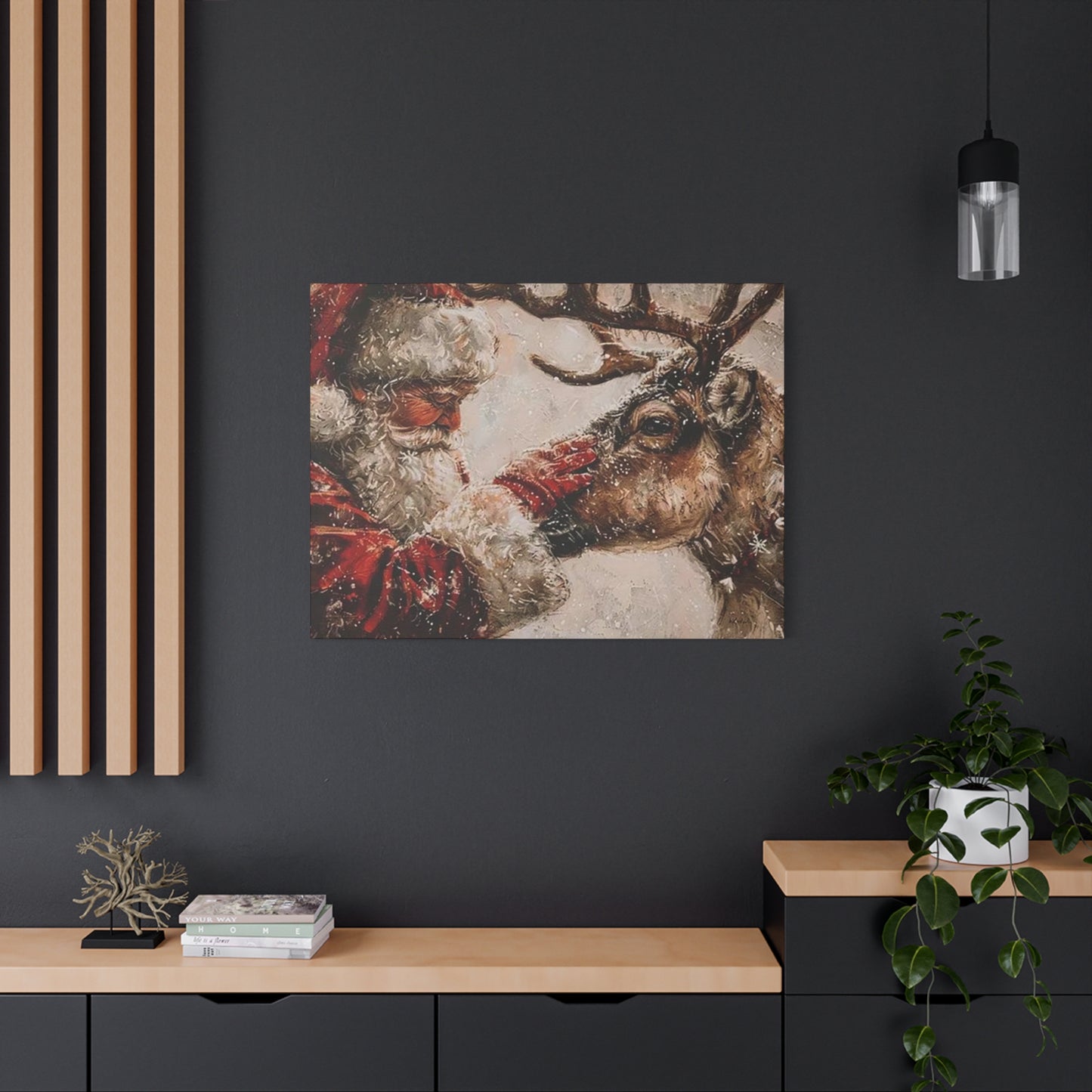Complete Guide to Santa and Reindeer Canvas Wall Art for Holiday Decorating
The tradition of decorating homes during the winter season has evolved remarkably over the centuries, and today's homeowners have access to countless creative options for bringing festive cheer into their living spaces. Among the most beloved and enduring symbols of this special time of year are images depicting jolly old Saint Nicholas and his magnificent team of flying reindeer soaring across moonlit skies. These iconic representations have found a perfect medium in modern canvas artwork, allowing families to capture the essence of holiday magic on their walls year after year. Canvas prints featuring these timeless subjects offer a sophisticated yet whimsical approach to seasonal decorating, combining artistic expression with nostalgic charm in ways that resonate with both children and adults alike.
Magical Santa Canvas Prints
The enchantment of canvas prints showcasing the legendary gift-giver represents more than simple decoration. These artistic pieces serve as portals to childhood wonder and family traditions that span generations. When selecting artwork featuring the beloved character in his iconic red suit, homeowners discover an incredible variety of artistic interpretations ranging from classical Victorian-era depictions to contemporary minimalist designs. The magic inherent in these prints lies not merely in their visual appeal but in their capacity to evoke powerful emotions and cherished memories.
Traditional representations often showcase the jolly figure with his characteristic rosy cheeks, twinkling eyes, and generous smile, typically portrayed against backgrounds of snow-covered landscapes or cozy workshop settings. These conventional images connect viewers to the historical roots of the tradition, drawing from centuries of folklore and cultural storytelling. The craftsmanship involved in creating high-quality canvas prints ensures that every detail, from the texture of fur trim to the sparkle in knowing eyes, is rendered with exceptional clarity and depth.
Modern interpretations bring fresh perspectives to familiar imagery, sometimes incorporating abstract elements, bold color palettes, or unexpected compositional arrangements. Some contemporary artists reimagine the traditional figure in urban settings or blend cultural influences from various global traditions. This diversity allows collectors and decorators to find pieces that align perfectly with their personal aesthetic preferences and existing home decor schemes.
The technical aspects of canvas printing technology have revolutionized how these magical images are reproduced and displayed. Advanced printing techniques capture subtle gradations in color and intricate details that were impossible to achieve with earlier reproduction methods. The canvas material itself adds dimension and texture, creating a more authentic artistic experience than flat paper prints. Many premium canvas prints feature gallery-wrapped edges, where the image continues around the sides of the frame, eliminating the need for traditional framing and creating a clean, contemporary presentation.
Placement considerations for these enchanting prints significantly impact their visual effect and emotional resonance. Living rooms benefit from larger statement pieces positioned above mantels or sofas, where they become natural focal points during gatherings and celebrations. Hallways and entryways transformed with these images greet guests with immediate festive warmth, setting the tone for the entire home. Children's bedrooms and playrooms take on extra magic when adorned with playful interpretations that fuel young imaginations throughout the season.
The durability and longevity of properly produced canvas prints make them valuable additions to family decoration collections. Unlike paper prints that fade or deteriorate quickly, quality canvas artwork maintains its vibrancy and structural integrity through many years of seasonal display. This longevity creates opportunities for prints to become beloved family heirlooms, recognized and anticipated by children who grow up seeing the same cherished images appear each year, eventually introducing these traditions to their own families.
Lighting plays a crucial role in maximizing the impact of these magical prints. Strategic placement of spotlights or picture lights enhances details and creates dramatic shadows that add depth and dimension. During evening hours, well-lit canvas art creates warm, inviting focal points that draw family members together. Some decorators coordinate their lighting schemes with the colors and mood of their canvas artwork, using warm amber bulbs to complement traditional imagery or cooler tones for more contemporary pieces.
Reindeer Flight Wall Art
The spectacle of magnificent reindeer in mid-flight captures imaginations with unparalleled power, representing freedom, magic, and the impossible made possible. Wall art depicting these legendary creatures soaring through night skies carries profound symbolic meaning beyond simple decoration. These images embody the spirit of belief, wonder, and the extraordinary possibilities that characterize the holiday season. The artistic representation of flying reindeer has evolved considerably over time, with artists exploring countless approaches to depicting grace, motion, and supernatural ability.
Historical depictions often emphasized the supernatural aspect of flight, showing reindeer with exaggerated musculature and dramatic poses that conveyed power and determination. Earlier artistic interpretations sometimes included fantastical elements like glowing hooves, sparkling trails, or ethereal auras surrounding the animals. These embellishments heightened the sense of magic and otherworldliness, clearly distinguishing these creatures from their earthbound counterparts. The emotional impact of such imagery connects viewers to the sense of awe and possibility that defines childhood wonder.
Contemporary artists approach the subject with varied techniques and perspectives, some emphasizing realism in anatomical details while maintaining the fantastical element of flight, others adopting stylized or abstract interpretations that focus on movement, energy, and emotion rather than literal representation. Wildlife artists bring expertise in animal anatomy and behavior to their depictions, creating images where the reindeer appear simultaneously naturalistic and magical. This combination of familiarity and fantasy creates particularly compelling artwork that appeals to diverse aesthetic sensibilities.
The composition of flight scenes offers artists numerous creative possibilities. Some works showcase entire teams in formation, creating dynamic diagonal lines across the canvas that guide the viewer's eye and convey motion and purpose. Others focus on individual animals or small groups, allowing for more detailed examination of form and expression. Background elements significantly influence the overall mood and impact, with options ranging from star-filled night skies and auroral displays to snow-covered villages and moonlit clouds.
Color choices in reindeer flight artwork profoundly affect the emotional tone and decorative versatility of pieces. Traditional palettes featuring deep blues, purples, and silvers create mystical, nocturnal atmospheres that complement classic holiday color schemes. Warmer interpretations incorporating golds, ambers, and russet tones generate cozier, more intimate feelings. Some bold contemporary pieces employ unexpected color combinations or gradients that create striking visual impact while maintaining thematic relevance.
The technical challenge of depicting believable flight presents artists with opportunities to demonstrate skill and creativity. Successful representations convey weight, momentum, and three-dimensional movement through careful attention to anatomy, perspective, and compositional dynamics. Details like flowing manes, extended legs, and alert postures communicate energy and purpose. Environmental elements such as trailing clouds, displaced snow, or atmospheric effects enhance the illusion of movement through space.
Scale considerations significantly impact how reindeer flight artwork functions within interior spaces. Oversized canvases create dramatic focal points that command attention and transform entire rooms, making them ideal for large living areas or spaces with high ceilings. Medium-sized pieces work beautifully in more intimate settings or as components of gallery wall arrangements. Smaller works offer flexibility for incorporating these beloved motifs into varied locations throughout homes, including spaces where larger pieces would overwhelm the available wall area.
The versatility of reindeer flight imagery allows it to complement numerous decorating styles beyond traditional holiday aesthetics. Modern farmhouse interiors benefit from slightly rustic interpretations with natural color palettes and textured finishes. Contemporary minimalist spaces can accommodate streamlined, graphic representations that maintain clean lines and limited color schemes. Even eclectic bohemian settings find harmony with more whimsical or folk-art inspired versions of this classic subject matter.
Christmas Cheer on Canvas
Capturing the essence of holiday joy and celebration through visual art requires sensitivity to the complex emotions and associations surrounding this special season. Canvas prints dedicated to expressing pure festive happiness serve as daily reminders of gratitude, connection, and optimism during the darkest days of winter. These cheerful images encompass wide-ranging subjects and styles, all unified by their capacity to uplift spirits and create positive emotional responses in viewers.
The psychological impact of surrounding ourselves with joyful imagery during the holiday season extends beyond mere decoration. Research in environmental psychology demonstrates that visual elements in our surroundings significantly influence mood, stress levels, and overall emotional well-being. Artwork radiating warmth, celebration, and happiness contributes to creating home environments that support mental health and family harmony during what can be an emotionally complex time of year for many individuals.
Artistic approaches to conveying holiday cheer vary enormously in technique and subject matter. Some pieces focus on gathering scenes showing families, friends, or communities coming together in celebration. These narrative images tell stories of connection and belonging, reminding viewers of the social bonds that provide meaning and support throughout life. Other works emphasize symbolic elements like decorated trees, wrapped gifts, or festive tablescapes that represent abundance, generosity, and preparation for special moments.
Abstract and impressionistic interpretations offer alternative approaches to capturing holiday spirit without relying on literal representation. These works employ color, texture, and composition to evoke feelings associated with the season rather than depicting specific subjects. Warm color palettes dominated by reds, golds, and greens communicate festivity through purely visual means. Textural techniques adding dimension and tactile interest create additional sensory engagement that enhances emotional impact.
The role of nostalgia in holiday cheer artwork cannot be overstated. Many beloved images reference earlier historical periods, mid-century aesthetics, or vintage design elements that connect viewers to childhood memories or idealized visions of traditional celebrations. This nostalgic quality provides comfort and continuity, linking present experiences to treasured memories and cultural heritage. Vintage-inspired canvas prints particularly appeal to those seeking to create warm, timeless holiday atmospheres in their homes.
Incorporating cheerful holiday canvas art into home decor requires consideration of how pieces interact with existing furnishings, color schemes, and architectural features. Successful integration ensures that seasonal artwork enhances rather than clashes with year-round decor elements. Neutral base palettes in furniture and walls provide flexibility for introducing colorful festive artwork without creating visual chaos. Conversely, rooms with existing bold colors benefit from artwork that complements or thoughtfully contrasts with dominant hues.
The temporary nature of seasonal decorating presents unique opportunities for creativity and renewal. Unlike permanent artwork that remains displayed throughout the year, holiday canvas prints emerge from storage annually, providing fresh visual interest and marking the passage of time. This cyclical appearance creates anticipation and ritual, with family members looking forward to reuniting with favorite images. The practice of carefully storing and preserving seasonal artwork also teaches valuable lessons about caring for meaningful possessions.
Layering various types of cheerful holiday artwork creates depth and visual richness in decorated spaces. Combining canvas prints with other decorative elements like wreaths, garlands, and small sculptures generates multidimensional displays that engage viewers from multiple angles. Varying the scale, style, and subject matter of different pieces prevents monotony while maintaining thematic coherence. This approach allows decorators to express creativity and personal taste while building comprehensive seasonal environments.
Santa and Sleigh in Art
The iconic imagery of a loaded sleigh guided by its legendary driver represents perhaps the most recognizable symbol of the holiday season worldwide. Artistic depictions of this scene carry profound cultural significance, appearing across countless variations in style, medium, and interpretation. The enduring appeal of this subject matter speaks to universal themes of generosity, wonder, and the magic of giving that transcend cultural and religious boundaries.
Historical evolution of sleigh imagery in art reflects changing cultural attitudes, artistic movements, and technological developments in reproduction and distribution. Early depictions drew from European folk traditions, portraying modest sleds and regional costume details specific to particular cultures. As the character and mythology became more standardized through the nineteenth and twentieth centuries, artistic representations increasingly converged around familiar elements while still allowing for individual creative interpretation.
The sleigh itself functions as a rich symbolic object worthy of artistic attention. As a vehicle enabling the impossible journey of gift delivery to every child in a single night, it represents the triumph of magic over physical limitations. Artists emphasize different aspects of this symbolism through their choices in depicting the vehicle. Some render elaborate, ornate sleighs suggesting fairy tale grandeur and importance. Others prefer simpler, more rustic designs that emphasize humble origins and folk tradition roots.
The contents of the sleigh present additional opportunities for artistic expression and narrative detail. Overflowing sacks and wrapped packages communicate abundance and generosity. Artists sometimes include partially visible toys or gifts, sparking viewers' imaginations about what treasures might be contained within. The arrangement and depiction of cargo also provide compositional elements that balance the visual weight of other components in the artwork.
Dynamic compositions capturing the sleigh in motion create particularly engaging artwork. Artists employ various techniques to convey speed and movement, including motion blur, trailing elements, and dynamic diagonal arrangements. The challenge of depicting a three-dimensional vehicle moving through space while maintaining visual clarity and aesthetic appeal demands considerable skill and artistic judgment. Successful compositions balance dynamism with readability, ensuring viewers can appreciate both overall impression and fine details.
Environmental context significantly influences the mood and impact of sleigh artwork. Night sky backgrounds with stars, moon, and aurora create magical, otherworldly atmospheres. Aerial views showing rooftops and chimneys below emphasize the extraordinary nature of the journey. Some artists include weather elements like falling snow or swirling clouds that interact with the sleigh and its occupants, adding drama and visual interest while reinforcing themes of winter and the season.
The relationship between driver and vehicle receives varied treatment across different artistic interpretations. Some works emphasize the commanding presence of the central figure steering the team with confidence and purpose. Others create more integrated compositions where figure and sleigh function as unified elements within larger scenes. The positioning, posture, and expression of the driver communicate personality and mood, from jovial and relaxed to focused and determined.
Color palettes in sleigh artwork range from traditional reds and greens to unconventional choices that create distinctive visual identities. While classic color schemes connect viewers to familiar imagery and cultural expectations, alternative palettes offer opportunities for creating unique pieces that stand apart from standard representations. Monochromatic or limited color approaches can emphasize form, texture, and composition while creating sophisticated, modern aesthetic effects.
Festive Holiday Wall Décor
Creating comprehensive holiday environments within homes extends far beyond placing a decorated tree in the living room. Wall decor plays a crucial role in transforming ordinary spaces into celebratory environments that engage occupants and visitors throughout the season. The thoughtful selection and arrangement of festive artwork, including canvas prints, establishes visual themes and emotional tones that define the character of holiday celebrations within particular households.
The psychology of decorated spaces reveals that environmental modifications significantly impact human behavior, emotion, and social interaction. Festively decorated rooms encourage gathering, conversation, and shared activities. They create backdrops for memory-making and photography. The visual richness of well-decorated spaces stimulates positive emotions and reduces stress, counterbalancing the pressures and challenges many people face during this busy time of year.
Strategic planning ensures that festive wall decor achieves maximum impact while maintaining visual harmony throughout homes. Beginning with focal point spaces like entryways, living rooms, and dining areas establishes strong first impressions and anchors for overall decorating schemes. These primary spaces typically receive the largest, most impactful pieces that clearly communicate holiday themes and aesthetic approaches. Secondary spaces including hallways, bedrooms, and home offices can then receive complementary treatments that extend themes without overwhelming smaller areas.
Balancing permanent and seasonal wall decor requires thoughtful consideration during planning stages. Some homeowners prefer removing all year-round artwork and replacing it entirely with holiday pieces, creating complete seasonal transformations. Others integrate festive additions with existing permanent collections, creating layered displays that maintain some continuity while clearly marking the special season. Neither approach is inherently superior; the choice depends on personal preferences, available storage, and the character of existing artwork.
The concept of gallery walls has gained tremendous popularity in contemporary interior design, and this approach translates beautifully to holiday decorating. Curated collections of related canvas prints in varying sizes create dynamic, visually interesting wall displays that offer more complexity than single large pieces. Gallery wall arrangements allow decorators to combine different subjects, styles, and formats within unified themes. The flexibility of this approach accommodates ongoing collection building, as new pieces can be integrated with existing favorites in fresh arrangements each season.
Texture and dimensionality add crucial interest to festive wall displays. While canvas prints provide wonderful visual content, combining them with three-dimensional elements creates richer, more engaging installations. Wreaths, garlands, and hanging ornaments positioned near or around canvas artwork add depth and variety. Some creative decorators use festive ribbon or greenery to frame or accent canvas pieces, creating custom presentations that change each year.
Lighting design profoundly influences how wall decor is perceived and appreciated. Natural daylight reveals colors and details clearly but changes significantly throughout days and seasons. Artificial lighting provides consistent illumination and creates opportunities for dramatic effects. Many successful holiday decorators employ multiple lighting sources at various levels, combining overhead fixtures, table lamps, and accent lighting to create layered, flexible illumination that adapts to different times and activities.
The relationship between wall decor and other decorative elements throughout rooms requires attention during planning. Color coordination between artwork and other decorations like throw pillows, table linens, and tree ornaments creates cohesive, intentional-looking environments. However, perfect matching can appear overly coordinated and sterile. Allowing some variation and contrast adds visual interest and prevents decorated spaces from feeling like showrooms rather than lived-in homes.
Flying Reindeer in Winter Sky
The magical spectacle of reindeer traversing winter night skies represents one of the most powerful and evocative images associated with holiday traditions. Artwork capturing these magnificent creatures against backdrop of stars, moon, and aurora creates dreamlike compositions that transport viewers into realms of wonder and possibility. The combination of realistic animal subjects with fantastical circumstances challenges artists to balance believability with magic, creating images that feel simultaneously grounded and ethereal.
Atmospheric conditions in winter skies provide artists with spectacular environmental elements to incorporate into compositions. The clarity of cold air allows stars to appear with brilliant intensity, creating glittering backgrounds that enhance magical moods. The moon, whether full and luminous or crescent and delicate, provides natural lighting that illuminates subjects while creating dramatic contrasts and shadows. Aurora borealis displays, with their shifting curtains of colored light, add movement and otherworldly beauty to northern sky scenes.
The challenge of depicting believable flight mechanics while maintaining artistic appeal requires careful attention to anatomy and physics. Reindeer possess specific physical proportions and characteristics that viewers recognize even if unconsciously. Artists must work within these constraints while suggesting the extraordinary strength and grace required for sustained flight. Details like extended legs suggesting propulsion, alert ears indicating awareness, and flowing manes creating motion lines all contribute to successful flight depictions.
Perspective and scale considerations significantly impact the emotional effect of flying reindeer artwork. Distant views showing small figures against vast skies emphasize the epic nature of the journey and create feelings of awe at the scope of the undertaking. Closer perspectives allowing viewers to see facial expressions and physical details create more intimate connections with individual animals. Some particularly effective compositions employ multiple perspective shifts within single images, showing both distant and near elements that create depth and spatial complexity.
The formation and arrangement of multiple reindeer within compositions presents interesting design challenges. Traditional depictions often show animals in neat lines or V-formations similar to migrating birds, emphasizing organization and purpose. More dynamic arrangements scatter subjects across the visual field at varied distances and angles, creating energetic, less formal compositions. The famous named reindeer offer opportunities for characterization, with some artists depicting subtle personality differences through posture, expression, or positioning.
Weather elements interacting with flying subjects add drama and visual interest while reinforcing winter settings. Swirling snow creates motion lines and depth cues. Clouds provide platforms for staging dramatic entrances or exits. Fog and mist create atmospheric perspective that enhances the illusion of distance. Ice crystals suspended in air can catch light, creating glittering effects that amplify magical qualities. These environmental details transform simple sky backgrounds into active, engaging elements that participate fully in compositions.
The time of night chosen for depiction significantly influences color palettes and mood. Early evening scenes with remnants of sunset glow offer opportunities for warm oranges and purples that transition to deeper blues. Midnight settings emphasize deep indigos and blacks punctuated by bright stars and moonlight. Pre-dawn moments can introduce pale blues and grays that suggest approaching morning. Each time frame carries different emotional associations and works better with certain overall aesthetic approaches.
Stylistic variations in winter sky imagery range from photorealistic renderings to highly stylized interpretations. Realistic approaches emphasize accurate anatomical details, natural colors, and convincing atmospheric effects. Impressionistic versions focus on capturing the feeling and essence of scenes through looser brushwork and expressive color choices. Graphic and illustrative styles reduce subjects to essential shapes and limited color palettes, creating bold, immediately readable images with strong decorative appeal.
Classic Santa Wall Prints
Traditional representations of the beloved gift-bringer have established deep roots in cultural consciousness through more than a century of artistic reproduction and commercial distribution. Classic imagery follows recognized conventions in costume details, physical appearance, and associated props that viewers worldwide immediately recognize and understand. These time-honored depictions connect contemporary celebrations to historical traditions and shared cultural heritage, providing continuity across generations.
The standardization of appearance occurred gradually through the nineteenth and early twentieth centuries as various regional traditions merged and popular culture solidified around particular visual characteristics. The distinctive red suit trimmed with white fur, black boots and belt, and characteristic facial features became universal through their reproduction in advertisements, greeting cards, story illustrations, and eventually film and television. This standardization created a visual vocabulary that artists could reference while still exercising creative interpretation.
Portrait-style prints focusing on the face and upper body create intimate, personal connections between subjects and viewers. These compositions emphasize facial expression, allowing artists to convey personality through eyes, smile, and subtle details. The direct gaze of portrait subjects creates psychological engagement that draws viewers in and establishes emotional relationships. Such pieces work particularly well in smaller spaces or as components of larger gallery arrangements where they provide focal points without requiring extensive wall area.
Full-figure depictions showing entire forms from head to toe allow artists to incorporate more narrative elements and environmental context. These compositions might show subjects carrying toy bags, consulting lists, eating cookies, or interacting with other characters. The additional visual information creates storytelling opportunities that engage viewers' imaginations and invite closer examination. Full-figure pieces generally require more wall space but offer greater visual impact and decorative presence.
Workshop settings provide popular background choices for classic prints, connecting subjects to their traditional roles as toy makers and gift preparers. These scenes often include busy elves, mountains of toys, workbenches cluttered with tools, and other details that build comprehensive narrative worlds. The warm, cozy atmosphere of workshop depictions appeals to viewers by creating spaces that feel both magical and comfortingly domestic. The abundance shown in workshop scenes reinforces themes of generosity and plenty.
Outdoor winter scenes offer alternative settings that emphasize connections to nature and seasonal beauty. Images of figures trudging through snow, standing among frost-covered trees, or pausing on rooftops under starry skies create different moods than workshop interiors. These outdoor settings often feel more adventurous and dynamic, showing subjects actively engaged in their legendary nocturnal journey. The contrast between warm costume colors and cool winter backgrounds creates visually striking compositions.
Vintage-style prints deliberately referencing historical artistic approaches have gained popularity among collectors and decorators seeking authentic traditional aesthetics. These pieces may replicate Victorian-era illustration techniques, mid-century commercial art styles, or folk art traditions from various cultures. The patina and character of vintage styling creates warmth and nostalgia while offering alternatives to slicker contemporary production values. Authentically aged or distressed finishes enhance the antique appeal of vintage-style canvas prints.
The versatility of classic imagery allows it to complement various interior design styles despite its traditional character. Modern farmhouse aesthetics embrace vintage sensibilities that pair naturally with classic prints. Traditional and country decor styles find obvious harmony with time-honored imagery. Even contemporary interiors can successfully incorporate classic prints when framed or presented in modern ways, creating interesting juxtapositions between old and new that add depth and character to spaces.
Holiday Magic Captured on Canvas
The intangible quality of enchantment that characterizes the season presents unique challenges and opportunities for visual artists. Successfully capturing magic on canvas requires more than technical skill; it demands sensitivity to emotion, cultural meaning, and the psychological factors that create wonder. Artists employ various strategies to convey supernatural elements and extraordinary circumstances while maintaining visual coherence and emotional authenticity.
Luminosity and light effects provide powerful tools for suggesting magical qualities in imagery. Glowing objects, radiant halos, sparkles, and light trails all signal supernatural occurrences to viewers. Artists control light sources, intensity, and color to create specific moods and emphasize particular elements. Dramatic lighting contrasts between illuminated focal points and darker surroundings draw attention and create visual drama. Subtle ambient glows suffusing entire scenes create gentler, more pervasive magical atmospheres.
Color choices significantly influence perceptions of magic and enchantment. Rich jewel tones suggest luxury and otherworldliness. Metallic sheens in golds and silvers convey preciousness and fairy tale qualities. Unexpected or impossible color combinations signal departures from normal reality. Some artists employ luminous, saturated colors that seem to glow from within, creating hypnotic visual effects. Others use pale, ethereal palettes suggesting frost, moonlight, and ghostly apparitions.
The inclusion of fantastical elements explicitly signals magical content to viewers. Flying subjects that normally cannot fly obviously indicate supernatural circumstances. Impossible architectures or landscapes that violate physical laws suggest dream worlds or alternate realities. Anthropomorphized animals or objects with human characteristics create whimsy and fantasy. These obvious departures from mundane reality give artists permission to break rules and explore imaginative possibilities.
More subtle approaches to conveying magic rely on mood, atmosphere, and suggestion rather than explicit fantasy elements. Ordinary subjects depicted in extraordinary lighting conditions or unusual contexts take on mysterious qualities. Viewers sense something special without necessarily identifying specific supernatural features. This restrained approach often proves effective for viewers who appreciate magical themes but prefer realistic artistic styles or more sophisticated aesthetic approaches.
Narrative content contributes significantly to magical impact by suggesting stories that extend beyond visible scenes. Viewers presented with mid-action moments naturally wonder what preceded and will follow depicted instant. This engagement of imagination creates active participation rather than passive viewing. Artists provide just enough information to establish situations while leaving sufficient ambiguity to invite speculation and personal interpretation.
Technical aspects of canvas production and presentation enhance magical qualities in printed artwork. Metallic inks or foil details catch light and create sparkle effects. Textured canvas surfaces add tactile dimension that enhances visual interest. Gallery-wrap presentations eliminating visible frames create floating effects that seem to suspend images in space. These production considerations extend artistic vision beyond original compositions into physical objects that occupy and transform spaces.
The placement and presentation of magical holiday canvas art within homes significantly affects impact and viewer experience. Dimmer switches allow occupants to control ambient lighting levels, creating opportunities for dramatic evening presentations where artwork glows mysteriously in darkened rooms. Positioning pieces where they become visible upon entering rooms creates moments of surprise and delight. Hanging magical artwork in unexpected locations like powder rooms or closets creates whimsical discoveries that enhance overall home environments.
Santa's Sleigh Ride Artwork
Depicting the legendary overnight journey requires artists to convey motion, purpose, and the passage through space and time. Unlike static portraits or still life compositions, sleigh ride artwork must suggest dynamic action and forward momentum while maintaining compositional balance and visual clarity. This challenge pushes artists to employ various technical strategies for communicating movement through inherently static visual media.
Motion lines and blurred elements provide conventional approaches to suggesting speed and movement. Trailing ribbons, flowing manes, or streaked backgrounds indicate rapid passage. Carefully controlled blur effects on some elements while maintaining sharp focus on others creates sense of frozen moment within ongoing action. These techniques borrowed from photography translate effectively to painted and printed imagery, communicating kinetic energy through visual metaphors viewers intuitively understand.
Compositional strategies using diagonal lines and asymmetrical arrangements create visual dynamism that implies movement. Subjects positioned entering or exiting frame edges suggest ongoing journeys extending beyond visible portions of scenes. Strong directional vectors created through alignment of multiple elements guide viewer attention while reinforcing sense of purposeful travel toward specific destinations. These structural decisions occur during initial composition planning and fundamentally influence overall dynamic impact.
The angle of view significantly affects emotional engagement and dramatic impact. Ground-level perspectives looking up at passing subjects create feelings of awe and emphasize the extraordinary nature of events. Aerial perspectives looking down create god's-eye views that show relationships between airborne travelers and communities below. Eye-level side views provide balanced perspectives allowing clear reading of subjects while maintaining some dramatic interest. Each viewing angle creates different relationships between viewers and subjects.
Sequential or multiple-moment compositions attempt to show progression through time within single artworks. These complex compositions might show subjects at different positions along their journey, creating cinematic effects similar to comic panel sequences. This ambitious approach requires careful compositional planning to prevent confusion while successfully communicating temporal progression. When successful, these pieces offer rich, engaging content rewarding sustained viewing and contemplation.
Environmental details establish settings and provide context for journeys depicted. Recognizable landmarks like clock towers, distinctive buildings, or geographical features help viewers situate action in particular locations. Visible seasonal decorations on buildings below reinforce holiday timing. Architectural variety suggesting different regions implies the global scope of travels. These contextual elements transform abstract flight scenes into grounded narratives with specific implications.
The representation of speed and distance traveled presents interesting challenges in static images. Artists suggest vast distances through background elements indicating different time zones, weather conditions, or geographical regions. Foreground and background elements at dramatically different scales imply deep space and extensive travel. Multiple smaller compositional elements scattered throughout images create complexity suggesting long journeys rather than brief trips.
Emotional tone in sleigh ride artwork varies considerably depending on artistic choices and intended effects. Some pieces emphasize joy and celebration through bright colors, smiling expressions, and festive details. Others create more contemplative or peaceful moods through quieter palettes and serene compositions. Dramatic interpretations using storm elements, challenging conditions, or intense expressions emphasize determination and effort. Each emotional approach resonates differently with various viewers and suits different decorative contexts.
Whimsical Christmas Canvas Art
The playful, lighthearted approach to holiday imagery offers delightful alternatives to more traditional or sentimental artistic interpretations. Whimsical art embraces humor, imagination, and creative freedom, often intentionally subverting expectations or combining unexpected elements. This approach particularly appeals to those seeking fresh perspectives on familiar themes or wishing to create more relaxed, fun holiday atmospheres in their homes.
Stylistic characteristics of whimsical art typically include simplified forms, exaggerated proportions, and playful color choices. Characters may have oversized heads, extremely expressive faces, or bodies in impossible positions. Animals might wear clothing or engage in human activities. Scale relationships may be deliberately unrealistic, with tiny figures riding enormous reindeer or miniature villages fitting in pockets. These departures from realism signal to viewers that they're entering worlds of imagination where normal rules need not apply.
Color palettes in whimsical holiday artwork often feature bright, saturated hues that create cheerful, energetic effects. Unexpected color combinations that wouldn't appear in more traditional pieces create visual surprise and delight. Some whimsical artists employ entire rainbow spectrums within single compositions, celebrating color variety and abundance. Others choose limited palettes of unusual colors, creating distinctive visual identities that stand apart from conventional holiday color schemes.
Subject matter in whimsical pieces frequently includes elements of surprise, humor, or gentle absurdity. Traditional characters might be shown in unexpected situations or contexts. Animals might engage in humorous activities or display anthropomorphic characteristics. Impossible scenarios played straight create deadpan humor. This lighter approach makes holiday imagery accessible and enjoyable for viewers who find more sentimental or traditional art overly serious or saccharine.
The influence of children's book illustration on whimsical holiday art is significant and readily apparent. Many whimsical artists draw inspiration from beloved illustrated books, employing similar techniques, compositional approaches, and narrative structures. This connection to children's literature creates nostalgic responses in adult viewers while simultaneously appealing to younger audiences. The crossover appeal makes whimsical pieces excellent choices for family spaces where decor should satisfy varied tastes and ages.
Folk art traditions from various cultures provide rich sources of inspiration for whimsical holiday artwork. Scandinavian design influences contribute minimalist forms, limited palettes, and charming animal characters. Latin American folk art brings vibrant colors and naive stylistic approaches. Eastern European traditions contribute intricate patterns and elaborate decorative details. These cultural influences add depth and authenticity to whimsical pieces while creating diverse aesthetic options for collectors and decorators.
Mixed media and collage techniques appear frequently in whimsical holiday art, adding textural variety and visual interest. Artists might combine painted elements with paper cutouts, fabric textures, or photographic components. This eclectic approach creates layered compositions with rich surface qualities that reward close examination. The handmade quality evident in mixed media pieces appeals to audiences valuing craft traditions and artisanal production values.
The versatility of whimsical Christmas canvas art allows successful integration into various interior design contexts. Modern and contemporary spaces benefit from the fresh, unconventional energy whimsical pieces provide. Eclectic and bohemian interiors naturally accommodate playful artwork. Even more traditional spaces can incorporate whimsical elements in specific rooms like children's areas or casual family rooms, creating zones with distinct characters within overall home environments.
Reindeer Magic for Home Walls
The symbolic significance of reindeer in holiday traditions extends beyond their role as mere transportation. These majestic animals embody wilderness, endurance, and adaptation to harsh northern environments. Their association with arctic regions connects holiday celebrations to ancient winter solstice traditions predating modern observances. Artwork celebrating these magnificent creatures brings elements of nature, wildness, and authentic seasonal connection into decorated homes.
Biological and behavioral characteristics of real reindeer provide fascinating context for their legendary counterparts. These large deer possess remarkable adaptations enabling survival in extreme cold, including specialized hooves, dense fur, and unique circulatory systems. Their seasonal migrations cover vast distances across harsh terrain. Their ability to find food beneath deep snow seems almost magical. Understanding real reindeer biology enriches appreciation for why these particular animals were chosen for legendary roles.
Artistic depictions of reindeer range from scientifically accurate wildlife illustrations to highly stylized or abstract representations. Naturalistic approaches emphasizing authentic anatomy, coloring, and behavior appeal to wildlife art enthusiasts and those appreciating natural world beauty. These realistic pieces provide educational value while maintaining decorative appeal. They work particularly well in homes with established nature or wildlife decor themes that extend beyond holiday seasons.
Stylized and decorative interpretations simplify forms, emphasize patterns, or exaggerate certain features for aesthetic effect. These approaches create designs with strong graphic impact suitable for contemporary interiors. Geometric representations reduce subjects to essential shapes and angles, creating modern, minimalist compositions. Pattern-based designs covering animals with decorative motifs transform them into ornamental elements. These stylistic choices appeal to audiences preferring more abstract or design-oriented art.
Cultural variations in reindeer imagery reflect different traditions and relationships with these animals. Scandinavian representations often incorporate traditional folk art patterns and design elements reflecting indigenous Sami culture. Russian artwork might include elements from Slavic folklore and Orthodox traditions. North American interpretations frequently draw from illustration traditions in literature and advertising. These cultural variations offer collectors opportunities to explore diverse aesthetic approaches while maintaining thematic coherence.
The magical transformation of ordinary reindeer into flying gift-carriers provides rich metaphorical content for artistic exploration. This transformation represents the power of belief, imagination, and wonder to transcend mundane reality. It celebrates the human capacity for myth-making and storytelling. Artists emphasize this transformative magic through various visual strategies including glowing effects, supernatural auras, or dramatic before-and-after contrasts within single compositions.
Seasonal and environmental context in reindeer artwork significantly influences overall mood and decorative impact. Winter landscapes with snow, ice, and bare trees emphasize the cold season and natural setting. Arctic scenes with northern lights and midnight sun create exotic, otherworldly atmospheres. Forest environments with evergreens and woodland elements bring warmth and shelter. Each setting choice creates different emotional resonances and works better with certain interior design approaches.
Conclusion
In conclusion, Santa and reindeer canvas wall art serves as a charming and heartwarming centerpiece for holiday decorating that captures the magic, joy, and timeless traditions of the festive season. This art form beautifully brings to life the iconic imagery of Santa Claus and his loyal reindeer, symbolizing the spirit of giving, family togetherness, and holiday cheer. Whether displayed in homes, offices, or public spaces, Santa and reindeer canvas art transforms ordinary walls into inviting scenes filled with warmth, wonder, and nostalgia.
One of the greatest appeals of Santa and reindeer canvas art is its ability to evoke emotional connections and holiday memories. The sight of Santa guiding his reindeer through snowy skies conjures feelings of childhood excitement, anticipation, and the enchanting stories that surround Christmas Eve. For many, this imagery rekindles the magic of the season and inspires joy and kindness. Incorporating such artwork into your holiday décor allows you to celebrate these cherished traditions while creating an atmosphere that welcomes family and guests alike.
In addition to its emotional resonance, Santa and reindeer wall art offers versatility in style and display options. From classic, vintage-inspired paintings with soft, muted tones to modern, vibrant illustrations with bold colors and dynamic compositions, there is a style to suit every taste and décor scheme. Canvas prints are particularly favored for their durability and texture, adding depth and richness to the artwork. Whether hung as a large statement piece or as part of a gallery wall featuring other holiday-themed art, Santa and reindeer canvases provide visual interest and festive spirit.
The artistry involved in creating Santa and reindeer canvas wall art also deserves recognition. Skilled artists pay close attention to detail, lighting, and composition to capture the ethereal glow of moonlight on snow, the sleek motion of flying reindeer, and the joyful expression of Santa Claus himself. This careful craftsmanship elevates the art beyond decoration, turning it into a storytelling medium that invites viewers to immerse themselves in the wonder of Christmas.
Moreover, Santa and reindeer canvas art encourages a sense of tradition and continuity. Many families use such pieces year after year, establishing them as part of their holiday rituals. This consistency adds comfort and familiarity to the season, making the artwork a beloved heirloom that can be passed down through generations. Choosing high-quality canvases ensures that the art remains vibrant and intact, ready to grace your walls for many holidays to come.
Another important benefit is the ease of incorporating this art into various holiday décor themes. Whether your style leans towards rustic farmhouse charm, elegant winter wonderland, or playful children’s Christmas rooms, Santa and reindeer canvases complement and enhance your existing decorations. Pairing the artwork with string lights, garlands, wreaths, and festive textiles creates a cohesive and inviting environment that captures the spirit of the season.
Santa and reindeer canvas wall art also offers excellent gift-giving potential. These pieces make thoughtful presents for family, friends, and colleagues, conveying warmth and festive goodwill. They are particularly well-suited for those who appreciate holiday traditions and enjoy decorating their homes with meaningful, beautiful artwork.Sustainability and ethical production are increasingly significant to today’s consumers, and many artists and manufacturers now offer eco-friendly canvas options. Choosing artwork produced with environmentally responsible materials and processes aligns your holiday decorating with values of care and respect for the planet, adding an extra layer of meaning to your festive celebrations.
Ultimately, Santa and reindeer canvas wall art is more than a decorative element—it is a celebration of the spirit of Christmas itself. It brings together artistry, tradition, and emotion to create a focal point that enhances holiday spaces with magic and joy. Whether you are looking to refresh your holiday décor or searching for the perfect gift, investing in Santa and reindeer canvas art is a choice that transforms your environment and elevates the festive mood.As the holiday season approaches, embracing the timeless charm of Santa and reindeer imagery through canvas wall art ensures that your space radiates warmth, wonder, and the true spirit of Christmas. It invites all who enter to share in the joy, hope, and generosity that make the holidays so special.

















